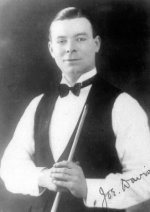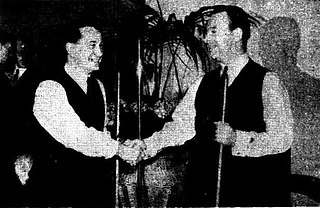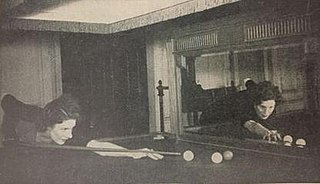
Joseph Davis was an English professional snooker and English billiards player. He was the dominant figure in snooker from the 1920s to the 1950s, and has been credited with inventing aspects of the way the game is now played, such as break-building. With the help of equipment manufacturer Bill Camkin, he drove the creation of the World Snooker Championship by persuading the Billiards Association and Control Council to recognise an official professional snooker championship in 1927. Davis won the first 15 world championships from 1927 to 1946, and he is the only undefeated player in World Snooker Championship history. In 1930, he scored the championship's first century break.

Walter Weir Wilson Donaldson was a Scottish professional snooker and billiards player. He contested eight consecutive world championship finals against Fred Davis from 1947 to 1954, and won the title in 1947 and 1950. Donaldson was known for his long potting and his consistency when playing, and had an aversion to the use of side. In 2012, he was inducted posthumously into the World Professional Billiards and Snooker Association's World Snooker Hall of Fame.

Horace Lindrum was an Australian professional snooker and billiards player. A dominant snooker player in Australia, he lived in Britain for long periods and played in the major British tournaments. From his arrival in Britain in 1935 he was regarded as the second best player in the world, behind Joe Davis. Lindrum contested three World Championship finals against Davis, in 1936, 1937 and 1946, losing all three to Davis but coming close to beating him on several occasions. Lindrum won the 1952 World Championship which, because of a dispute between the governing body and the players' association, was only contested by himself and New Zealander Clark McConachy.
The 1933 World Snooker Championship, known at the time as the Professional Championship of Snooker, was a snooker tournament held between 23 March and 16 June at various venues in England, with the final beginning on 12 June 1933 at Joe Davis's Saloon in Chesterfield, England. It was the seventh edition of the championship, and Joe Davis won his seventh title by defeating Willie Smith by 25 frames to 18 in the final. The highest break of the tournament was 72, compiled by Davis in the fortieth frame of the final.

The 1946 World Snooker Championship was a professional snooker tournament held from 4 February to 18 May 1946. Joe Davis won the title by defeating Horace Lindrum by 78 frames to 67 in the final, although the winning margin was reached at 73–62. It was Davis's fifteenth championship win, maintaining his unbeaten record in the tournament since its first edition in 1927. The highest break of the event was 136, a new championship record, compiled by Davis in the final.
The 1947 World Snooker Championship was a professional snooker tournament that took place from 20 January to 25 October 1947. The final was held at the Leicester Square Hall in London, England, from 13 to 25 October. The semi-finals were completed in March, but the final was delayed due to building works at the venue, which had been bombed in October 1940. Walter Donaldson won the title by defeating Fred Davis by 82 frames to 63 in the final, although he reached the winning margin earlier, at 73–49. Davis made the highest break of the tournament with a 135 clearance in frame 86 of the final.
The 1948 World Snooker Championship was a professional snooker tournament that took place from 9 March to 1 May 1948. It was an edition of the World Snooker Championship first held in 1927. A qualifying event with eight participants was held from 1 to 13 December 1947 at Burroughes Hall and was won by John Pulman, who joined seven other players in the main event.
The World Professional Match-play Championship was a professional snooker tournament established in 1952 as an alternative to the professional World Snooker Championship by some of the professional players, following a dispute with the Billiards Association and Control Council, the sport's governing body. Fred Davis won the first five editions of the tournament, but didn't participate in 1957, when John Pulman won. After this, the event was discontinued due to a decline in the popularity of snooker.

Joyce Gardner (1910–1981) was an English professional English billiards player. She was the Women's Professional Billiards Champion from 1931 to 1933, and from 1935 to 1938.

Ruth Harrison was an English snooker and billiards player. She won the Women's Professional Snooker Championship each year from its inception in 1934 to 1940, and again when it was next held, in 1948. She also won the Women's Professional Billiards Championship three times.
The Women's Professional Snooker Championship was a snooker tournament run from 1934 to 1950 by the Women's Billiards Association. The event was the world championship for female players during this time. Ruth Harrison was the most successful player, winning eight of the ten events. The event was later replaced by the World Women's Snooker Championship.
The Women's Professional Billiards Championship was an English billiards tournament held from 1930 to 1950. The tournament was first organised by Burroughes and Watts in 1930 and 1931, before the WBA ran the event until its conclusion in 1950. Joyce Gardner won the tournament on seven of the fourteen times that it was held, and was runner-up six times; the only time that she was not in the final was the 1940 tournament. The other players to hold the title were Thelma Carpenter who won four times, and Ruth Harrison who took three championship titles. Harrison's break of 197 in 1937 remains a women's record in competitive billiards.

Thelma Carpenter was an English billiards and snooker player. She won the Women's Professional Billiards Championship three times, and the Women's Professional Snooker Championship once.
The Women's Billiards Association (WBA), founded in 1931 and based in London, United Kingdom, was the governing body for women's English billiards and snooker, and organised the Women's Professional Billiards Championship and Women's Professional Snooker Championship as well as amateur and junior competitions. The founding meeting was held on 13 May 1931 at the Women's Automobile and Sports Association. The meeting was chaired by Teresa Billington-Greig and appointed Viscountess Elibank as the first president and Mrs Longworth as the first chairman. The WBA ran amateur and professional billiards competitions starting from 1932, an amateur snooker tournament from 1933, and a professional snooker championship from 1934.
Eva Collins was an English snooker and billiards player. She was runner-up in the 1930 British Women's Billiards Championship, and in its successor tournament, the Women's Professional Billiards Championship in 1931.
The 1976 Women's World Open was a women's snooker tournament that took place in Middlesbrough in 1976. Vera Selby won the final 4–0 against Muriel Hazeldene.
Muriel Hazeldene was an English snooker and billiards player. She was runner-up to Vera Selby in the 1976 Women's World Open snooker championship.

World Women's Snooker, founded as the World Ladies Billiards and Snooker Association (WLBSA) in 1981, and known as World Ladies Billiards and Snooker (WLBS) from 2015 to 2018, is a subsidiary company of the World Professional Billiards and Snooker Association concerned with governing and promoting snooker and billiards for women.
The Billiards and Snooker Control Council (B&SCC) was the governing body of the games of English billiards and snooker and organised professional and amateur championships in both sports. It was formed in 1919 by the union of the Billiards Association and the Billiards Control Club.
The World Women's Billiards Championship is an English billiards tournament, first held in 1931 when organised by the cue sports company Burroughes and Watts then run from 1932 by the Women's Billiards Association (WBA). It is currently run under the auspices of World Billiards Ltd (WBL), a subsidiary company of the World Professional Billiards and Snooker Association.







